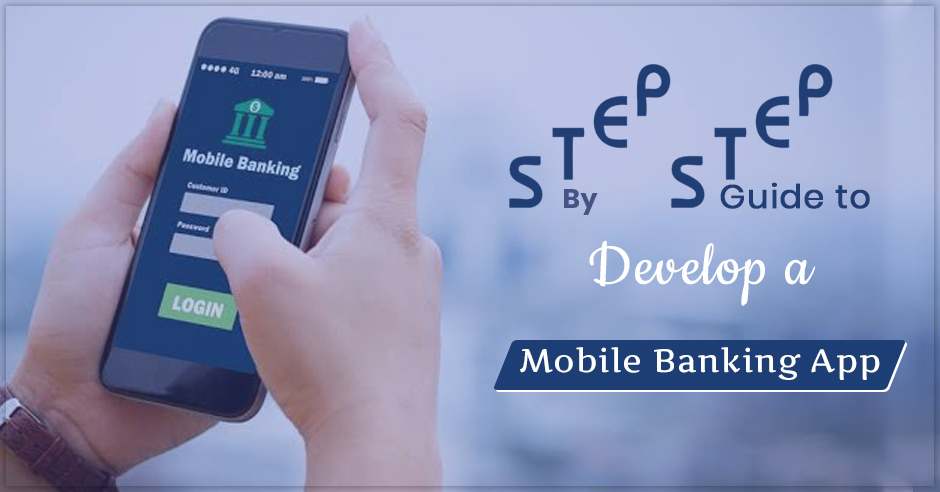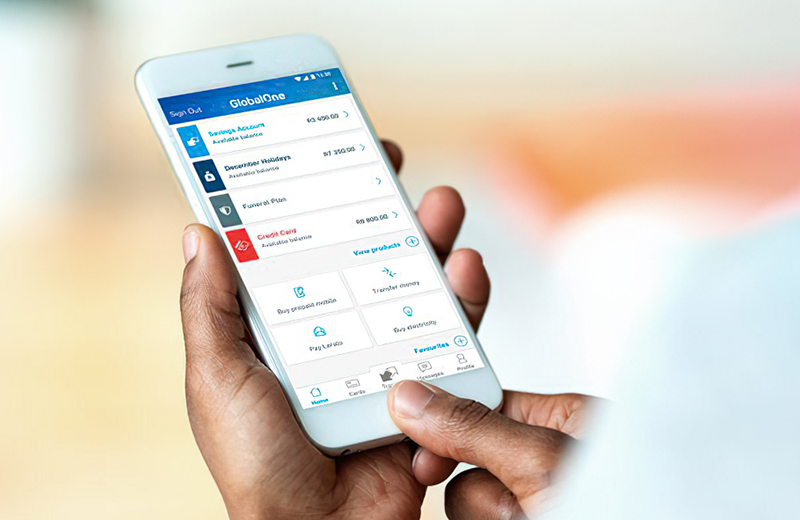
Easy Steps to Creating a Mobile Banking App
The current trend for banking mobile app development has recently accelerated. For your next project, follow these 7 steps to banking application development. Guest Posting the mobile banking app development has recently become a trend in the software development industry. The reason for this is that the coronavirus pandemic has slowed global economic growth, and as a result, the banking sector appears to have suffered greatly. Many financial institutions will face increased bad debts and non-performing assets (NPA). Furthermore, their high operational costs will exacerbate losses, making it difficult for some banks to meet even the Break-Even point.
Banking industry experts predict that once the pandemic is over, banks will have to reform their operations by shifting toward digital banking. Many banking institutions have recently emerged that only operate through digital channels, resulting in significantly lower operational costs when compared to traditional banking infrastructure.
It should be noted that this is not only due to the pandemic, but there is also a growing customer preference for mobile banking. In 2018, 69% of Britons used online banking on a regular basis. The reason for the growing popularity of online banking is self-evident. Internet banking via mobile banking apps is convenient and accessible. It virtually eliminates the need to go to the bank and wait in line for hours. Banking mobile app development enables users to use their mobile devices to access services from anywhere.
According to a Citi report, 91% of the bank’s customers prefer mobile banking apps to visiting the bank. Furthermore, 68% of millennials think their smartphone can replace their physical wallet.
Why are customers making the switch to mobile banking apps?
And the straightforward answer is “Mobility.” Customers will almost certainly benefit from the mobility provided by mobile banking apps. Prior to the digital revolution, customers had to physically visit a bank to obtain banking services. They can now get better banking services at home thanks to increased mobility of banking services.
In addition to providing customers with their bank account information at their fingertips, mobile banking application development has the following advantages:
- Provide 24-hour support and access to banking services, eliminating the customer’s traditional interaction with banks.
- Improved security and ease of use.
- A single solution for all banking services, from checking account balances to purchasing mutual funds.
- Customers save time by not having to visit banks for general services.
- With mobile banking apps, money transfers do not take days; instead, funds are transferred immediately.
- With all of the customer data available, banks can personalize their services, which is a huge benefit to the customers.
- Customers can track their spending through mobile banking apps.
- Regular payments can be automated using mobile banking apps.
- How do customers interact with mobile banking apps?
According to a Federal Reserve Board report from 2016, the following are the customer motivations for using a mobile banking app:
- On mobile banking apps, 94% of users check their account balance and recent transactions.
- To transfer money between bank accounts, 61% use mobile banking apps.
- 57% expect to receive important bank alerts.
- 48% use mobile banking apps to pay bills and deposit checks electronically via the camera on their phone.
- 40% of users use mobile banking apps to locate the nearest ATM or bank branch.
- Another 2018 Statista survey found some compelling reasons why Americans use mobile banking apps. According to the survey, 90% of users check their account balances using mobile banking apps. 79% want to see their recent transactions, and 59% want to pay bills.
- 57% use mobile banking apps to transfer funds, while 20% contact customer service, 19% open a new account, and 17% reorder checkbooks.
The highest priority will be security.
Your primary concern should be the security of the banking mobile app. There is no doubt that your mobile banking app must be simple to use, but you must also keep the user’s bank information and money secure. Here are some statistics to demonstrate why effective security is the most important feature of your mobile banking app:
- Almost 76% of banking customers are concerned about the security of their data when using mobile banking apps.
- If users believe the app security is inadequate, 48% will switch banks.
- Payments are the source of the data.
Fintech regulations are already stringent and strictly enforced. Furthermore, app security is taken very seriously by the mobile app markets (Playstore and iOS). If your app does not meet their security standards, they will not even publish it. The following are some steps you can take to make your banking mobile app more resistant to cybercrime:
- Select a secure and dependable data storage option.
- Use two-factor authentication.
- Never keep login credentials, sensitive data, or transaction information on your mobile device.
- Consider using session inactivity time.
- Using a manual or guide, instruct users on app security.
- Test the app for security flaws before releasing it.
- Banking Application Development in Seven Easy Steps
1. Conduct a study
The first step in developing a mobile banking app is to conduct market research. Determine the competitors, user personas, alternative solutions, and so on. This is necessary in order to determine what factors will make your app the best in the market, or at least the best in your market segment.
Failure to conduct proper market research will be a mistake because it will be difficult to identify customer pain points without first understanding the market. There can be no solution unless the issues are identified. Knowing the pain points will assist you in developing an app toolkit.
2. Prototyping and wireframing
Every app begins with a concept. Well, the requirements for mobile banking application development are well thought out long before the idea is commercialized. However, incorporating those requirements and features into a streamlined user experience is a difficult task.
It’s best to start with a low-fidelity wireframing process, sketching out the home screens, dashboards, and user journey. To be clear, wireframes typically do not contain any colors other than black and white.
It is now time to transform your wireframe into a clickable prototype that includes a basic presentation of the app interface and layouts. You can use dummy text and graphics to get a sense of how the app will function.
3. Create Your App
While technologies and back-end development are important for a smooth mobile app development process, the most important factor when it comes to user experience is the app design. While there are numerous tips on the internet for designing your app, here are some for banking application development:
- Color schemes, icons, typography, buttons, and forms should all be consistent with the bank’s brand guidelines.
- The app navigation should be logical and convenient for users.
- Icons, forms, and buttons, for example, should be simple to understand.
- The graphics should have meaning; you can use images or GIFs to give users the impression that the app is safe and friendly.
- Users from various regions will use the app; you must consider cultural differences.
4. Select the Tech Stack
To create the best architecture for your banking mobile application development, you should concentrate on the front-end, back-end, cross-platform frameworks, and some essential features such as security, availability, and robustness. You can choose between two types of banking mobile app development: native apps and hybrid apps. Both have their own set of advantages and disadvantages.
Native apps are fast and dependable. While native app development is more expensive, it is recommended for established businesses and funded startups, such as banks and venture-backed fintechs. Native apps enable developers to use the native functionality of mobile operating systems (iOS and Android), resulting in an exceptional user experience.
Hybrid apps, on the other hand, are designed to work across multiple mobile platforms with a unified codebase. These apps are built with web technologies like HTML, CSS, and JS. Furthermore, hybrid apps can function as PWAs (Progressive Web Applications). Frameworks for creating hybrid apps include Ionic Framework, Flutter, Kotlin, Phone Gap, and Xamarin.
5. Create and test
This is where the banking app concept comes to life. It is the most expensive stage of banking mobile app development because it necessitates a significant amount of time and effort on the part of developers.
According to IT industry trends, the best approach is to use agile development methodology, which allows for a faster development cycle and more reliable software. Using existing customer data, the agile methodology enables rapid and flexible banking app development. This iterative development process will assist banks in developing more innovative products and services.
6. Market and Reaction
When the development and testing phases are complete and you are ready to market the app, upload it to the appropriate app stores. You must concentrate on the feedback because, no matter how accurately you assumed the customer preferences and journey, there will always be flaws that must be addressed with feedback.
7. Enhance and Update
Depending on the feedback, you should continue to improve the app and implement the updates. And don’t forget to notify customers about new features that you’ve added with each update!
Seamless customer onboarding should be one of your Mobile Banking App’s features.
Customer onboarding for digital banking is not as simple as it is for other applications. There are government regulations that must be followed when developing the signup process. Identity requirements, such as KYC, should be simplified for new customers.
Profiles of Users
The user information is included in the user profile (name, phone number, email address, bank branch, bank account details, etc.). As a result, password/PIN authentication is required when making changes to basic user information.
History of Transactions
This feature allows users to access their online passbook directly from the mobile banking app. Online transaction history statements can be used as an authentic passbook statement in the majority of cases.
The transaction details should be presented in a very simplified manner so that users, regardless of their banking knowledge, can understand them. The statements should be available in PDF and Excel formats for download.
- Notifications via Push
- Push notifications are required for all applications, including banking mobile apps. Push notifications are typically classified into three types:
- Promotional – alert users to special offers, discounts, and deals.
- Transactional – These are critical for mobile banking apps because they inform users about account-related information such as debits, credits, payment requests, and so on.
- App-based notifications – These notifications ask users to submit pending documents or change their passwords.
- Find the nearest bank branch and ATMs.
It is not a novel feature to include in a mobile banking app. It demonstrates to your customers how much you value their convenience. Google Maps must be integrated into your native/hybrid banking mobile app. However, if you want the ‘nearby branch and ATM’ feature option in your banking app to fully function, you must obtain the user’s permission to obtain their location.
Payments based on QR Codes/USSD
Any mobile banking app’s purpose is to make the banking services process more convenient. Checking account balances and exploring available services are only a small part of banking services. Making or accepting payments is one of the most important functions of any bank.
Users of your banking mobile app may be able to make payments by scanning the receiver’s QR code or entering the receiver’s account information. QR code payments are dependable and simple because all the user has to do is point the mobile camera at the QR code. The QR codes contain information about the recipient’s bank account.
USSD transactions are another convenient way to pay with mobile banking. The USSD payment feature, on the other hand, has nothing to do with banking mobile apps, but it should be integrated with the app in areas where internet connectivity is limited. Customers can enjoy a seamless banking experience even if they do not have internet access by using USSD payments.
Some advanced Spending Tracker features for your Mobile Banking App
Keeping track of one’s expenses can be a time-consuming task for an individual, but it’s a simple matter of an algorithm for a mobile banking app. An algorithm that tracks the costs of all of your customers’ transactions. While it is not a bank’s responsibility to account for their customers’ expenses, including such a feature in the app will increase user retention and satisfaction.
Bills must be paid repeatedly
People pay certain bills on a regular basis. Payment reminder features in the banking mobile app can help them remember such payment dues. If the user grants permission, the feature can also make automatic payments for such services or bills.
Cashback or Bonus Points
Customer loyalty programs are popular in this day and age of digital transformation. While cashback/rewards are commonly used in the eCommerce industry, banks can also benefit from this feature. Banks already offer reward points for credit card transactions, and similar offers can be introduced with mobile banking app payments or by raising bank brand awareness.
Bill Splitting
This feature is included in the majority of modern e-wallet payment solutions because it improves user retention and payments to a higher level. Your customers will appreciate this feature because it eliminates the need for them to use a third-party bill splitting application when they can do it through their bank.
Finishing Up
There was a time when banks’ differentiation criteria were limited to interest rates and reliability. Banks are supposed to make their customers’ lives easier in today’s technologically advanced world.
With this recent trend and pandemic, banks must improve their digital banking infrastructure and begin providing banking services via mobile applications. Because there are many features that can be integrated into the app, the cost of mobile banking app development cannot be calculated without knowing the exact requirements.
Nimble AppGenie specializes in developing fintech mobile applications and can assist you with your digital banking infrastructure by providing a feature-rich mobile banking app. Please contact us right away for a quote.



